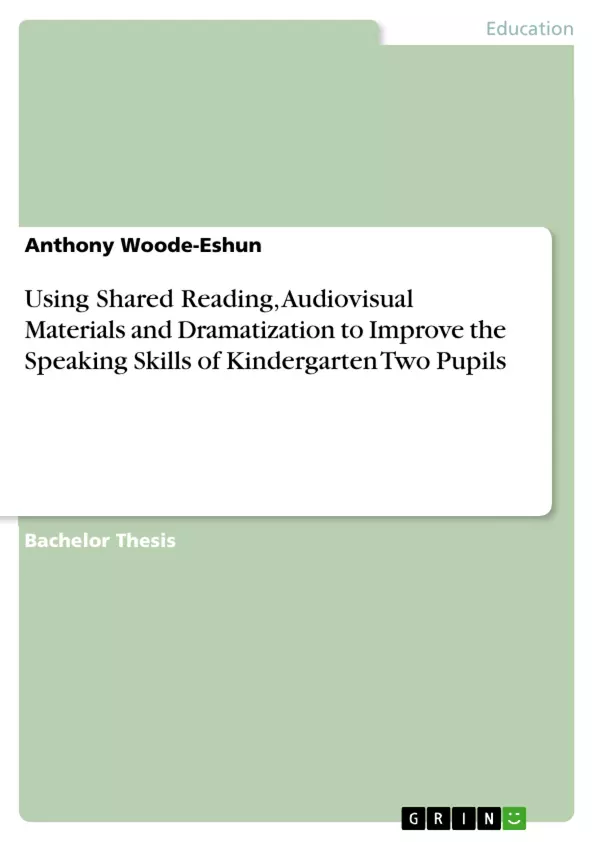The purpose of this study was to identify the causes of poor speaking skills among pupils and to suggest developmentally appropriate language activities that can help improve upon their listening and speaking skills. The study involved 47 pupils. After taking pupils through the implementation of the interventions in accordance with the research objectives, I realized that, there was tremendous change in the performance of pupils when discussion, storytelling and dramatization were used as intervention strategies.
Pupils' participation and interest in oral communication improved overwhelmingly within the duration of the interventions. In view of this, it was recommended that in as much as possible, teachers should use developmentally appropriate language activities in teaching children listening and speaking in the targeted language.
The researcher also recommended that the ministry of education and all stake holders should try as much as possible to equip the Early Childhood Care and Development centers with adequate and appropriate teaching and learning materials to enhance the speaking skills of children.
Inhaltsverzeichnis (Table of Contents)
- ABSTRACT
- CHAPTER ONE: INTRODUCTION
- Overview
- Background to the Study
- Statement of the Problem
- Purpose of the Study
- Objectives
- Research Questions
- Significance of the Study
- Delimitation
- CHAPTER TWO: LITERATURE REVIEW
- Introduction
- Concept of Literacy
- Concept of Speaking
- Concept of Shared Reading
- Concept of Audiovisual Materials
- Concept of Dramatization
- Summary
- CHAPTER THREE: METHODOLOGY
- Introduction
- Research Design
- Population
- Sample and Sampling Technique
- Research Instruments
- Data Collection Procedure
- INTERVENTION PROCESSES
- Pre Intervention
- Week One
- Week Two - Shared Reading Activities
- Week Three - The Use of Audiovisual Materials
- Week Four - Dramatization of familiar activities
- Week Five - Dramatization of stories
- Week Six: Revision
- Post Intervention
- Week Seven
- Method of Data Analysis
- CHAPTER FOUR: RESULTS AND DISCUSSION OF DATA
- Introduction
- Pre Observation on Pupils' Fluency of Speech
- Post Observation on Pupils' Fluency of Speech
- Comparing Pre-tests and Post tests
- Discussion of research questions
- Impact of shared reading, audiovisual materials, and dramatization on kindergarten pupils' speaking skills
- Developmentally appropriate language activities for enhancing listening and speaking skills
- The role of teachers in promoting oral communication in early childhood education
- Importance of providing adequate teaching and learning materials for fostering speaking skills
- The relationship between speaking, listening, reading, and writing skills
Zielsetzung und Themenschwerpunkte (Objectives and Key Themes)
The study aimed to identify the causes of poor speaking skills among kindergarten pupils and to suggest developmentally appropriate language activities that can enhance their listening and speaking skills. The study involved 47 pupils and utilized interventions like shared reading, audiovisual materials, and dramatization to assess their impact on the pupils' speaking skills.
Zusammenfassung der Kapitel (Chapter Summaries)
Chapter One: Introduction
This chapter provides an overview of the study, including the background, statement of the problem, purpose, objectives, research questions, significance, and delimitation. It emphasizes the importance of language development for children's overall development and the significance of speaking skills within the broader context of English language acquisition.
Chapter Two: Literature Review
This chapter explores the theoretical framework underpinning the study, discussing the concepts of literacy, speaking, shared reading, audiovisual materials, and dramatization. It delves into the literature on these concepts and their relevance to early childhood education and language development.
Chapter Three: Methodology
This chapter outlines the research design, population, sample, sampling technique, research instruments, data collection procedure, and intervention processes. It details the steps taken to conduct the study, including the implementation of interventions and data collection methods.
Schlüsselwörter (Keywords)
The primary keywords and focus topics of the study include: early childhood education, speaking skills, language development, shared reading, audiovisual materials, dramatization, intervention strategies, teaching and learning materials, communicative competence, and developmentally appropriate practices.
- Arbeit zitieren
- Anthony Woode-Eshun (Autor:in), 2018, Using Shared Reading, Audiovisual Materials and Dramatization to Improve the Speaking Skills of Kindergarten Two Pupils, München, GRIN Verlag, https://www.grin.com/document/512529



